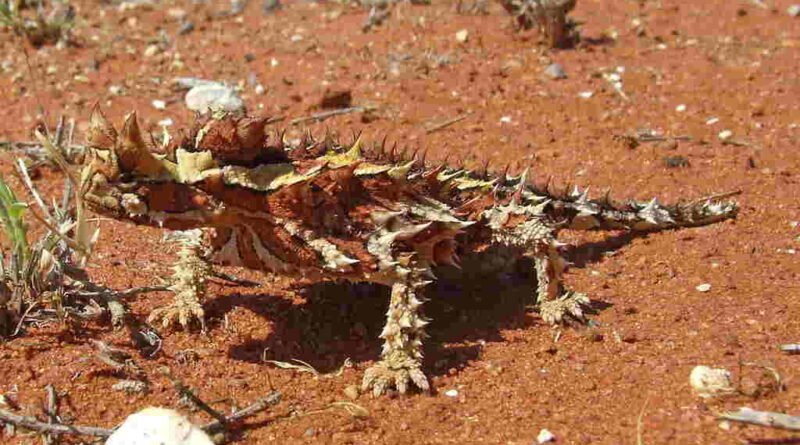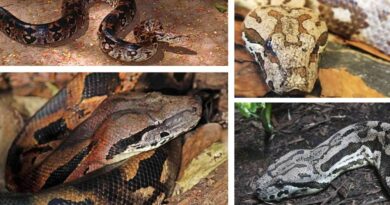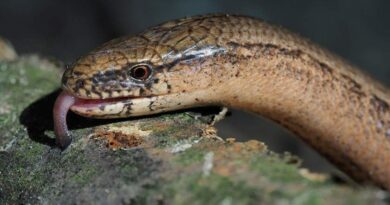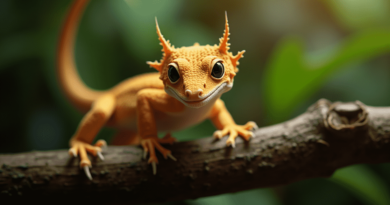Thorny Devil
Fascinating Facts About the Thorny Devil
The Thorny Devil, also known as Moloch horridus, is a remarkable species of lizard found only in Australia. This unique reptile, often called the mountain devil, belongs to the Agamidae family and is the sole species in the genus Moloch. The thorny dragon has a distinct look, covered in sharp spines that help it blend into its desert habitat. It typically grows to about 21 cm (8.3 in) in total length, including its tail. Interestingly, females are slightly larger than males, showing sexual dimorphism. They have a range length between 76 mm (2.99 in) and 110 mm (4.33 in), and their mass ranges from 28.5 g (1.00 oz) to 57 g (2.01 oz). As a heterothermic species, this lizard can adjust its body temperature to survive the harsh Australian climate.
Taxonomy
The Thorny Devil, scientifically classified by biologist John Edward Gray in 1841, belongs to the genus Moloch. Taxonomists often suspect that this species, although distantly related to North American horned lizards in the genus Phrynosoma, shares many morphologically similar features due to convergent evolution. This similarity in appearance, with horned scales on the head, gives the thorny lizard an almost mythical look, like a miniature dragon or devil. The name Moloch even references an ancient deity from the Near East, associated with a hideous beast, hence its nicknames like “devil lizard” or “thorny toad.” These thorny devils thrive in the Great Sandy Desert of Australia, adapted to its sandy soils.
Detailed Description
The Thorny Devil is a fascinating lizard that typically grows to about 21 cm (8.3 in) in total length, including its tail, and can live for 15 to 20 years. Females are generally larger than males, showing distinct sexual dimorphism. This species thrives in the desert, blending into its surroundings with camouflaging shades of browns, tans, and pale hues. The thorny devil darkens in cold weather and lightens in warm weather, using these color changes to regulate its body temperature. It is covered in conical spines and uncalcified spikes, particularly on the upper side of its body, which serve both as protection and to evade predators.
A notable feature of the thorny devil is the presence of spiny cones and boneless parietal spines on its back, as well as bony bosses on its skull, providing extra defense. Its small eyes and non-overlapping scales contribute to its rugged look. The ventral surface of the lizard is also covered in conical scales, which help with water retention and defense. In a unique defensive trait, when threatened, the thorny devil dips its real head and presents a false head made of soft tissue located on the back of its neck, confusing potential predators. Additionally, its slow gait involves a rocking motion, making it appear less noticeable as it moves in search of food, water, or mates.
The thorny devil has an incredible adaptation to collect water in the dry desert. Its skin features hydrophilic and superhydrophilic microstructures that allow it to absorb even trace amounts of water from dew, condensation, or by rubbing against moist surfaces. This water is channeled through small, interconnected channels that cover the entire body, transporting it to the mouth. The thorny devil’s keratinous and fibered epidermis ensures that moisture spreads across the scale surfaces quickly for faster uptake. It uses its body to collect water by rubbing against damp surfaces or even shoveling damp sand onto its back. Additionally, femoral pores on its ventral surface and its primitive agamid phalangeal formula highlight its evolutionary uniqueness as an Australian agamid.
Distribution and habitat
The Thorny Devil thrives in the arid regions of central Australia, inhabiting deserts, scrublands, sandplains, and sand ridges. It is well-adapted to areas with sandy loam, rocky, and hard soils, particularly in the mallee belt and interior deserts of Western Australia. These lizards can also be found in tropical terrestrial habitats, where they live among spinifex grasses, Triodea, acacia scrub, and mulga vegetation. Studies tracking thorny devils have shown that while they may wander over 100 meters in a few years, they generally stay in exclusive home ranges. Males and females have been observed to cover distances up to 500 meters, with an average daily movement of 77.9 meters within their territorial areas.
Self-defense
The Thorny Devil is well-protected by its body, which is covered in hard, sharp spines that help dissuade attacks from predators. These spines make the thorny devil difficult to swallow, especially for wild birds and goannas. When threatened, the thorny devil has an additional trick: it lowers its real head and uses its false head, located on the back of its neck, to confuse predators. This clever deception helps the thorny devil avoid being consumed. Furthermore, its teeth are modified for an ant specialist diet, designed to shear through the chitin of hard-bodied ants and other insects.
Diet and Feeding
The Thorny Devil is a specialized ant-eater, or obligate myrmecophage, feeding almost exclusively on ants from various genera, including Iridomyrmex, Ochetellus flavipes, Crematogaster, Camponotus, and Pheidole. This lizard consumes thousands of ants each day, with a feeding rate of about 2.9 ants per minute. As a sit-and-wait predator, the thorny devil positions itself near terrestrial trails or under cover, such as Triodia tussocks and currant bushes, where ants pass by. Despite the low nutritive value of ants, which are high in chitin and formic acid, the thorny devil has a large stomach to digest around 750 ants daily. This high volume of consumption ensures sufficient energy, with a metabolizable energy rate of about 59% and 70% assimilation of its insect-based diet. The best feeding times for the thorny devil are in the morning and late afternoon, around 11 a.m. and 3 to 6 p.m..
In the dry desert environment, the thorny devil collects moisture through unique adaptations. It absorbs dew that forms on its skin in the early morning as the outside temperature begins to warm. The dew and rain are channeled by capillary action along the spines and the intercalary grooves of its body to the mouth. This process allows the thorny devil to drink water passively. It can even absorb moisture from damp sand by pressing its body against the ground, utilizing capillary movement from condensation at the spine base and legs. This ensures a reliable source of water intake in the arid regions it inhabits.
Reproduction
Mating and Laying Eggs
Thorny devils mate between late winter and early summer, usually from August to December. After mating, females dig oviposition burrows on southern-facing sand ridges at depths of 15 cm to 22 cm, where they lay three to ten eggs. These eggs are incubated for about 90 to 132 days, with a mean of 118 days, before hatchlings emerge weighing around 1.8 grams and measuring 63 to 65 mm in snout-to-vent length. The eggs hatch after three to four months, typically from September to December, and both males and females are the same size at hatching, growing at similar rates in the first year. However, females tend to grow faster and reach maturity by five years old.
Key Reproductive Features
Thorny devils are iteroparous and have a seasonal breeding cycle, which happens yearly between late winter and early summer, typically from August to December. These sexual creatures are oviparous, meaning they lay eggs rather than giving live birth. During the breeding season, females produce anywhere from 3 to 10 offspring, and the gestation period lasts between 90 and 132 days, with the average being about 118 days.
Fat Stores and Oviposition
Female thorny devils rely on fat stores to provide energy for oviposition. These reserves fluctuate seasonally, with lower fat levels in summer and more fat stored in winter. Before laying eggs, they mobilize fat to supply essential nutrients for the developing eggs. In some cases, three females studied lost between 37% and 42% of their body weight during this process, showing how crucial fat reserves are for successful reproduction.
Parental Investment
In thorny devils, parental investment mainly occurs pre-fertilization. The female takes on the role of provisioning and protecting the eggs by choosing a safe place to lay them and ensuring the nest is properly covered. Before hatching, the female invests energy in developing the eggs and providing nutrients, a key part of the pre-hatching care. However, once the eggs are laid, there is no further provisioning or care after birth.
Lifespan/Longevity
Thorny devils have an impressive lifespan that ranges from 6 years to as long as 20 years in the wild. Their ability to survive in harsh desert environments plays a significant role in their longevity, with some individuals thriving for two decades under optimal conditions.
Daily and Seasonal Activity
Thorny devils are diurnal, meaning they are active during the day, with their body temperature regulated by the field temperature. They exhibit bimodal activity, being most active in fall (from March to May) and late winter to early summer (August to December). In contrast, they become inactive during the hottest months (January to February) and coldest months (June to July), often seeking refuge in burrows. These semi-nomadic creatures dig shallow burrows, about 10 cm deep, and adjust their behavior based on ant availability, becoming more sedentary in summer and fall, usually near shrubs and ant trails. Their defecation sites, often located under shrub cover, are marked by small fecal pellets scattered across sand. Thorny devils also search for mates during the morning of August and September, wandering near burrows and leaving distinctive tracks. They are primarily solitary and terricolous, living on the ground.
Predation and Anti-Predator Adaptations
Thorny devils face predation from animals like Australian bustards (Ardeotis australis), black-breasted buzzards (Hamirostra melanosternon), goannas (Varanus), snakes, dingos (Canis lupus familiaris), and red foxes (Vulpes vulpes), as well as humans (Homo sapiens). Their primary defence is their armored bodies covered in thorny spines and their camouflaged coloration, which helps them blend into their environment. When threatened, they use a false head located on their back by tucking their real head between their forelegs to confuse a predator. They can also remain motionless, use slow movements, or make jerky movements to appear less noticeable. If grabbed, they might puff up by taking in air, making it difficult for predators to swallow them. Their cryptic coloration and spiny decoration add further protection, making them appear more threatening.
Ecosystem Roles
Thorny devils are ant-specialists, feeding almost exclusively on ants, which allows them to have a significant impact on local ant populations. As insectivorous reptiles, they share their environment with other agamid lizards like Ctenophorus isolepis and Ctenophorus inermis, which have a more generalized insect diet. Thorny devils can also be parasitized by nematode worms like Parapharyngodon kartana and Abbreviata species. These parasites, along with termites as intermediate hosts, eventually infect the lizard, making them definitive hosts for other parasites like the tapeworm Oochoristica piankai, found in their guts.
Commensal/Parasitic Species
Thorny devils often host various parasitic species in their bodies. The most common are tapeworms like Oochoristica piankai, which settle in their intestines. They are also infected by nematode worms, such as Parapharyngodon kartana and Abbreviata species. These parasites thrive inside the thorny devil, living off their host while completing their life cycles.
Economic Importance for Humans: Positive
The thorny devil is a fascinating creature, often becoming a popular attraction in zoos because of its unique appearance and extreme morphology. Its body is covered in spines, which makes it stand out and sparks curiosity. This, in turn, contributes to education about wildlife, particularly animals from harsh landscapes like the deserts of Australia. Additionally, their specialized diets, consisting mostly of ants, have led to important research into how animals adapt to survive in such extreme conditions. People benefit from learning about these adaptations, both in understanding biodiversity and in supporting conservation efforts through educational programs.
Economic Importance for Humans: Negative
The thorny devil poses no adverse impacts on humans from an economic perspective. While its presence in the wild may seem concerning due to its intimidating appearance and ability to thrive in harsh landscapes, it doesn’t cause any harm to human activities or agriculture. In fact, because of its specialized diet of ants and unique adaptations, it plays a neutral role in the ecosystem, with no direct negative effects on human life or economy.
Conservation Status
The thorny devil has not been thoroughly evaluated for its conservation status, which is why it is not listed on the IUCN Red List or in the CITES appendices. Despite its fascinating adaptations to survive in harsh desert environments, there has been limited formal assessment of its population health. This lack of evaluation may be due to its stable presence in the wild, where it doesn’t face significant threats. However, the absence of a clear status could also mean that more research is needed to ensure the species continues to thrive.
Are thorny devils endangered?
The thorny devil is not currently considered endangered, but like many animals in the wild, it faces challenges that could affect its future. For example, their nests and eggs can be vulnerable to predators that threaten the survival of babies after hatching. Some efforts, such as using wire enclosures, can help protect them from these dangers, playing a role in saving these unique creatures from potential threats. Although they are not at immediate risk, continued attention to their habitat and breeding practices is important for ensuring their long-term survival.
Watching thorny devils is a thrill
Seeing the iconic Thorny Devil in the wild is a dream for many Australian wildlife enthusiasts. During a 2016 and 2017 road trip through Queensland and Western Australia, covering over 16,000km from Perth to Darwin, I was lucky to spot and photograph more than 60 reptile species, including this unique lizard. Found basking in the sun during the hottest parts of the day, like at 2pm in temperatures reaching 35°C around 600km north of Perth, the thorny devil tolerates extreme heat. Using both a wide-angle lens and a macro lens allowed me to capture incredible details—its spines lit by the sun’s rays, while avoiding harsh shadows by using an external flash. The result was a portrait that highlighted the lizard’s distinctive features, like the tilt of its head, the downward curvature of its mouth, and the suspicious squint in its eye. Each encounter with this fascinating reptile felt magical, and its ability to thrive in such harsh conditions made it a true highlight of the journey.
Popular reference
The thorny devil has been part of interesting and often anecdotal stories, especially during and after World War II when American servicemen stationed in Southwest Australia encountered it. One well-known scam involved locals selling what they claimed were thorny devil eggs, but these were actually thorny fruits or seeds from the double gee (Emex australis), a type of weed. This petty scam played on the unfamiliarity of the servicemen with the local wildlife. Although these stories add some intrigue, thorny devils are now more commonly seen in captivity, where they continue to fascinate people.



